
The Highland Railway (HR) was one of the smaller British railways before the Railways Act 1921, operating north of Perth railway station in Scotland and serving the farthest north of Britain. Based in Inverness, the company was formed by merger in 1865, absorbing over 249 miles (401 km) of line. It continued to expand, reaching Wick and Thurso in the north and Kyle of Lochalsh in the west, eventually serving the counties of Caithness, Sutherland, Ross & Cromarty, Inverness, Perth, Nairn, Moray and Banff. Southward it connected with the Caledonian Railway at Stanley Junction, north of Perth, and eastward with the Great North of Scotland Railway at Boat of Garten, Elgin, Keith and Portessie.
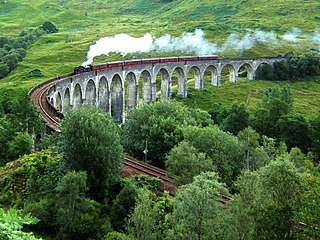
The Glenfinnan Viaduct is a railway viaduct on the West Highland Line in Glenfinnan, Inverness-shire, Scotland. Located at the top of Loch Shiel in the West Highlands of Scotland, the viaduct overlooks the Glenfinnan Monument and the waters of Loch Shiel.

Fort William railway station is a railway station serving the town of Fort William in the Highland region of Scotland.
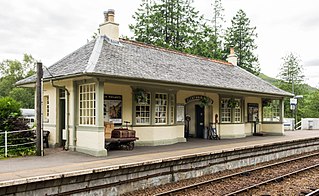
Glenfinnan railway station is a railway station serving the village of Glenfinnan in the Highland council area of Scotland. It is on the West Highland Line. Glenfinnan Viaduct is about two-thirds of a mile (1.1 km) to the east of the station.

Mallaig railway station is a railway station serving the ferry port of Mallaig, Lochaber, in the Highland region of Scotland. This station is a terminus on the West Highland Line, 41 miles (66 km) by rail from Fort William and 164 miles (264 km) from Glasgow Queen Street railway station.

The Invergarry and Fort Augustus Railway was a branch-line railway built in Scotland, connecting the named places with the main line at Spean Bridge. It opened in 1903.
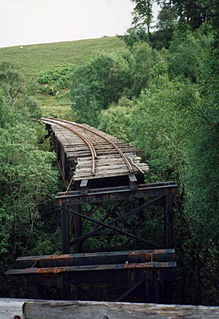
The Lochaber Narrow Gauge Railway was a 3 ft narrow-gauge industrial railway. It was a relatively long line, built for the construction and subsequent maintenance of a 15 miles (24 km) long tunnel from Loch Treig to a factory near Fort William in Scotland. The tunnel was excavated to carry water for the Lochaber hydroelectric scheme in connection with aluminium production by British Aluminium. The railway came to be known colloquially as the 'Old Puggy Line'.
Fort William Junction is a railway junction on the West Highland Line in Scotland, located to the east of Fort William railway station. It is where the railway to Mallaig connects with the Glasgow to Fort William railway.

The Morar Railway Viaduct is a railway viaduct that carries the West Highland Line over the River Morar.

The Loch nan Uamh Viaduct is a railway viaduct that carries the West Highland Line.

The Arnabol Viaduct carries the West Highland Line over the Arnabol Burn.

The Larichmore Viaduct is a railway viaduct in Scotland that carries the West Highland Line over the Brunery Burn.

The Banavie Railway Swing Bridge carries the West Highland Line across the Caledonian Canal at Banavie.
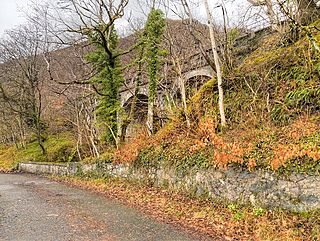
The Falls of Cruachan Railway Viaduct is a railway viaduct that carries the West Highland Line over the Falls of Cruachan, near Loch Awe.

The Long Key Bridge, officially known as the Dante B. Fascell Bridge, is a bridge in the Florida Keys connecting Long Key and Conch Key, roughly halfway between Miami and Key West. At a length of nearly two and a half miles, it is the second longest bridge on the Overseas Highway after the Seven Mile Bridge. The current bridge opened in 1982, replacing the parallel Long Key Viaduct, which carried the Overseas Railroad from 1907 to 1935 and was repurposed for highway use shortly after.

Banavie Pier railway station was the terminus of a short branch and was at first known as Banvie, opened by the North British Railway in 1895. The station's location was just above the impressive flight of locks on the Caledonian Canal known as "Neptune's Staircase", Banavie, Highland council area, Scotland.
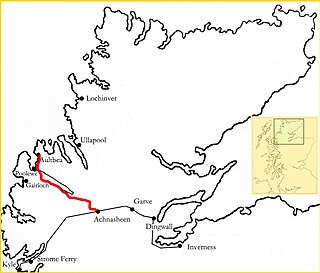
The Loch Maree and Aultbea Railway was one of several branch railway-lines proposed for the North-West Highlands of Scotland in the early 1890s. Although a full survey was conducted in 1892 and a Private Bill was submitted to the Westminster Parliament on 18 November 1892, the necessary Act to permit construction did not receive approval and the plan was dropped.



















